Detection of Chloroquine in Opium Using GC-MS: A Toxic Adulterant for Opium Abusers
Tahir Jamshaid*, Muhammad Usman, Zahid Mahmood, Imtiaz Hussain, Abid Naseer, Muhammad Taimoor Chaudhary and Mohammad A Tahir
*Forensic Scientist, Punjab Forensic Science Agency, Pakistan
Submission:February 19, 2021;Published:March 10, 2021
*Corresponding author:Tahir Jamshaid, Forensic Scientist, Punjab Forensic Science Agency, Lahore, Pakistan
How to cite this article: Kertzman S, Kagan A, Vainder M, Hegedish O, Lapidus R, Weizman, A. Narcissistic Personality Measures Discriminate Between Young Women With and Without Tattoos. J Forensic Sci & Criminal Inves. 2021; 15(2): 555906 DOI:10.19080/JFSCI.2021.15.555909.
Abstract
Opium is most common drug of abuse after Cannabis obtained from Papaver somniferum. It is extensively cultivated and produced in Afghanistan, Myanmar, and Indo-Pak areas. It contains narcotic and psychotropic alkaloids. The principal alkaloids of Opium have been exclusively evaluated both qualitatively and quantitatively using various techniques. It is smuggled and trafficked as body packers, swallowing and mules across international borders. The opium ingestion and its body packing for trafficking respectively are of major concern as far as its in-vitro toxicity is concerned. The raw opium resin is either ingested as such or consumed in the form of local drinks in Asian countries. The ingestion of Opium and rupturing of packets inside body during trafficking causes direct absorption of high doses of Opium alkaloids thus increasing mortality rate over the past decades. In this study, Opium (resin and plant material) was analyzed qualitatively using Gas-Chromatography-Mass Spectrometry Technique and despite of major opium alkaloids, Chloroquine was detected frequently in various samples as previously no literature was found for its detection during Opium characterization. The toxicity and lethal effects of Chloroquine among accidental infesters, suicidal and postmortem toxicological cases have been studied. This study revealed the detection of Chloroquine in resins as compared to the plant material. The Opium itself is very much lethal as far as its abuse and ingestion is concerned and the detection of Chloroquine among Opium alkaloids also poses huge concern over its toxicity.
Keywords: Opium; Lethal effects; Chloroquine; Toxic adulterant; Asian countries; Alkaloids
Abbreviations: FID: Flame Ionization Detector; GS: Gas Chromatography; HLPC: High-Performance Liquid Chromatography; DAD: Diode Array Detector; CZE: Capillary Zone Electrophoresis; UPLC-Q-TOF; Ultra-High Performance Liqu
Background
Opium is a dried milky resin obtained from unripe seed pods of Papaver somniferum L. The production of opium globally in 2013 (World Drug Report 2014) is about 5500 tons out of which major part of it is produced in Afghanistan and Myanmar (80% and 10% respectively) [1]. Various alkaloids have been detected in Opium in the past few decades using GC method to establish a triangular plot for different opium location sources [2]. Opium poppy contains more than eighty tetrahydrobenzyl isoquinoline-derived alkaloids including the pharmaceutically important analgesic and narcotic drug morphine, the cough suppressant codeine, as well as the muscle relaxant papaverine, the antitumoric agent noscapine and the antimicrobial sanguinarine. Other biosynthetic intermediates, such as reticuline, scoulerine, dehydroreticuline, salutaridine, laudanine and Laudanosine, were present in small amounts only [3]. The most used methods for qualitative detection and quantitative estimation of opium alkaloids include gas chromatography (GC) with mass spectrometry and flame ionization detector (FID) [4] high-performance liquid chromatography (HPLC) [5,6] and capillary electrophoresis with a diode array detector (DAD) [7-10]. Ultra-high performance liquid chromatography-quadruple time-of-flight (UPLC-Q-TOF) has also been used for characterization of opium and found to be highly selective and sensitive. thus, helping in sample preparations [11]. On the other side, combined gas chromatography-mass spectrometry (GC-MS) has been used for the forensic identification of opium constituents [12]. In a study, 124 Opium samples from different Indian territories were analyzed for major alkaloids (codeine, Thebain, papaverine, morphine and narcotine) using capillary zone electrophoresis (CZE) and it was found to be helpful for forensic differentiation of Indian opium from other sources [13]. Some of the minor alkaloids like oripavine, reticuline and narceine have been classified by Reid R G et al. [14] along with major one’s form 80 opium samples from Turkey, Yugoslavia, India, and Persia [14]. The use of minor opium alkaloids in Heroin profiling have also been studied by Lurie IS et al. [15] thus helping the discrimination of Opium from different origins [15]. Opium alkaloids were determined from opium poppy (Papaver somniferum) along with semi-synthetic derivatives. These alkaloids have greater importance in industrial setup, clinical and forensic science. Two reagents namely, tris (2,2′-bipyridyl) ruthenium (II) and acidic potassium permanganate showed excellent sensitivity in a study as Liquid-phase chemiluminescence reagents. This has been used in in the progress of variety of analytical measures using flow analysis, high-performance liquid chromatography, capillary electrophoresis, and microfluidic instrumentation [16]. The Opium is usually smuggled as body packers, swallowers or mules that are the people who smuggle illicit drugs internationally either by swallowing the packets, insertion into rectum and vagina. Plastic bags, balloons or condoms are used for such purpose and after arrival in the target country they retrieve it [17]. Body packers frequently use constipating drugs, such as diphenoxylate to sustain the packet in body for longer period. Transient times for packets may be between 2 days and 3 weeks [18]. After entering the destination site, they use laxatives or enemas to help pass their packets rectally [19]. Body Stuffers are the group of people who conceal or ingest the drugs when encountered by law enforcement personnel [20,21]. The body packet may contain approximately 8-10 gram of drug and rupturing of single packet is life-threatening. CT scan is quite helpful for diagnosing opium body packers [17]. Symptoms of toxicity of drug are likely to appear in body stuffers due to poor packaging of the drug and leakage from packets resulting in severe toxicity and death [20]. Cocaine and Heroin are usually snuggled by such methods. It has been estimated that in prisons, 90 % of opiate drugs are trafficked intra-rectally or vaginally. Clinical diagnosis and laboratory findings are helpful in evaluation and management of severe (some time lethal) drug intoxication [17]. The production of Opium is distributed at golden triangle consuming 90% Laos, Myanmar, Thailand along with Afghanistan, Pakistan, and Iran. The transportation of drugs is of great importance at the vicinity of the golden crescent specially Europe [22]. Chemically, Chloroquine is 7-Chloro-4-(4-diethylamino-1-methylbutylamino) quinoline) belonging to 4-aminochinoline group (Figure 1-8). It was synthesized and developed as Resochin by German researchers in 1934. In 1946, it was drug of choice in chemoprophylaxis of malaria intestinal amebiasis was efficiently treated later along with porphyria cutanea, solar urticaria, and polymorphous light eruption. Due to the narrow margin between therapeutic and toxic dose, fatal Chloroquine poisonings in either suicide or murder cases come to notice from time to time. The detection methods for Chloroquine and its metabolites in human body fluids, and organ samples include NMR-spectroscopy, RIA, TLC, spectrophotometric methods GC, GC/MS =, and mostly HPLC. This paper describes the separation and analysis of Chloroquine after fatal overdose in postmortem specimens using GC/MS. Chloroquine is most historic and common antimalarial drug and used as anti-inflammatory agent in dermatological, rheumatologic, and connective tissue disorders causing retinal and cardiovascular toxicity. Spanish Jesuit missionaries learned from indigenous Indian tribes of a medicinal bark used for the treatment of fevers. With this bark, the Countess of Chinchón, the wife of the Viceroy of Peru, was cured of her fever later named Peruvian bark and the tree as Cinchona after the countess. A well-known antimalarial drug quinine was obtained from this bark. In 1946, Chloroquine was developed as an effective and safe antimalarial in 1946 by British and U.S. scientists. A German chemistry student, Othmer Zeidler, synthesized DDT in 1874, for his thesis. The insecticidal property of DDT was not discovered until 1939 by Paul Müller in Switzerland. Various militaries in WWII utilized the new insecticide initially for control of louse-borne typhus. DDT was used for malaria control at the end of WWII after it had proven effective against malaria-carrying mosquitoes by British, Italian, and American scientists. Müller won the Nobel Prize for Medicine in 1948 [23]. A 60-year-old woman with longstanding rheumatoid arthritis received multidrug treatment, including prolonged administration of Chloroquine. She developed complete heart block requiring a permanent pacemaker, congestive heart failure, and progressive myopathy. Although hypertension and possibly amyloidosis were thought to be the cause of her cardiac disease, cardiac and skeletal muscle changes characteristic of Chloroquine toxicity were observed [24]. Fatal Chloroquine poisonings has been observed in suicide or murder cases due to narrow therapeutic and toxic margin resulting in extremely dangerous consequences. In severe cases of over dosage, adequate lifesupporting measures and intensive care treatment should be considered. Gastrointestinal absorption of Chloroquine is rapid and almost complete (about 90%) resulting in nausea, drowsiness, tremor, vomiting and abdominal pain after about 30 minutes. Clinical features of toxicity further include hypokalemia, cardiac arrhythmia, respiratory depression, and coma [25]. According to Kelly and colleagues, the maximum plasma concentration is attained between 1.5 and 3h after ingestion [26]. The toxic range is reported between 0.5-1.0mg/ l [27]. Due to its vast use in prevention and treatment of malaria, the chances for accidental ingestion in children and attempted suicide in adults have increased [28]. In adults, severe intoxications with fatal outcome are associated with plasma levels of more than 3mg/ l. [29]. Death usually occurs within 3h of ingestion of an overdose [30]. A study conducted in Malaysia and Singapore stated that purity and percentage of street Heroin for common abuse has decreased from 30-50% to 3-5%. Major adulterants like Caffeine and Chloroquine were detected in various seized samples abundantly. The DEA North Central Laboratory (Chicago, Illinois) received exhibits seized by U.S. Customs and Border Protection Inspectors at the airport. Analysis of the powder by FTIR, GC/FID, and GC/MS confirmed 68 percent heroin hydrochloride with small quantities of acetaminophen, caffeine, and Chloroquine [31]. Through improved forensic capacities and facilities, the forensic laboratory of the Counter Narcotics Police of Afghanistan (CNPA) was able to identify several cutting agents typically used for mixing with heroin. The samples were seized during law enforcement activities in 2008. The chemicals identified include caffeine, Chloroquine, phenolphthalein, and paracetamol. Chloroquine has been used as a cutting agent in heroin for many years, though it was not previously known to be used in Afghanistan. Chloroquine does not alter the effects of heroin or influence the way it can be consumed. Its widespread availability, low price, color, and crystalline structure are thought to be some of the reasons for its use. Chloroquine have been thought to be marketed as “fake heroin” due to close resemblance in appearance and consistency with some seizures in South-West Asia. It is not a common additive in illicit street heroin but had been reported to be found in heroin from Afghanistan, Iran, and Pakistan. The reason for the addition of chloroquine is not certain. As per some Malaysian experts, Chloroquine was added to prevent cramps afflicting chronic heroin users, while others speculated that it prolonged the effect of heroin by inhibiting the P-450 cytochrome which catalysis heroin’s breakdown. Quinine is said to mimic the respiratory “rush” felt by injecting heroin users shortly after administration [32].
Experimental
Suspected seized materials were submitted at author’s lab by law enforcement agencies for detection of Opium. The data was collected for year 2017, 2018 and 2019. Out of all the submitted samples of Opium in Lab, 180 samples of Opium (50 samples of resin and plant material for each year) were selected randomly based on statistical probability basis for qualitative study. The resin samples were extracted in Methanol (AR grade) and qualitatively analyzed using Gas Chromatography-Mass spectrometry. For the analysis of plant material (crushed poppy pods and plant material), about 2 grams of material was taken, soaked in methanol for about 2 to 3 hours. The methanol extract of plant material was then concentrated by heating at 50-60 ⁰C and concentrated methanolic solution was analyzed on GC-MS using method validated at author’s lab. A gas chromatographic system 7890A series (Agilent Technologies, Palo Alto, CA, USA) coupled to MSD 5977 (Triple Axis Detector) with ALS 7693. Agilent DB- 5MS Ultra Inert column (30m length x 250μm ID x 0.25μm film thickness) was used for the separation of constituents of analyte. Injection volume of 1μL was used in split mode in 50:1 ratio at 250°C. Helium gas was used as carrier gas with 1mL/min flow rate with inlet pressure 31.8 psi. Oven temperature for GC column at 150 °C upheld for 1min and then gradually increased to 300°C at 25°C/min. The total run time was set up for 12min. The temperature for MS source and MS Quad were 230°C and 150°C used, respectively. Scan mode for m/z from 43-550 was done. Agilent GC Chemstation was used for data analysis. Results were compared with reference library (AAFS2010, NIST and SWGDRUG) and reference standard.
Results and Discussion
Opium resin is obtained from the exudates of ripened Opium poppy pods. Various opium alkaloids have been identified and elucidated in the resin so far. Suspected seized materials were submitted at author’s lab by law enforcement agencies for detection of Opium. The retention time (RT) in GC chromatograms for each compound was quite efficiently resolved. The chromatogram obtained with this method produced resolution of Codeine (RT 6.57 ± 0.2 minutes), Morphine (RT 6.65 ± 0.2 minutes), Thebain (RT 6.82 ± 0.2 minutes), Papaverine (RT 7.92 ± 0.2 minutes), Noscapine (RT 9.75 ± 0.2 minutes) and Chloroquine (RT 7.26 ± 0.2 minutes). Major alkaloids of opium were confirmed by comparing MS ions with standards as Morphine (285, 215, 162, 286, 124, 70, 59, 284), Codeine (299, 229, 214, 162, 124, 115, 300), Thebain (311, 296, 312, 297, 242, 165, 239, 152), Papavarine (339, 338, 324, 308, 154, 325, 340, 293) and Noscapine (220, 221, 205, 218, 147, 219, 203, 178). Despite major Opium Alkaloids, Chloroquine (86, 30, 58, 87, 42, 73, 56, 29, 319, 41) an antimalarial drug, [33] was detected frequently in high abundance in the samples of Opium resin only. The data was collected for Opium resin and plant material were selected randomly for qualitative study. Out of 180 cases (year 2017-2019), Chloroquine was detected in Opium resin 28% of total cases in 2017, 13% in 2018 and 30% in 2019 and it was not detected in plant material samples (Table 1). It has also been observed that Chloroquine was detected in Opium resin only while crushed plant material showed no traces of Chloroquine. This is the indication of the fact that it might have been added during collection or trafficking of resin but not the plant material. The abundance of Chloroquine was found to be quite high in the chromatograms of Opium resin where detected (Figure 1-8). A comprehensive literature survey was conducted in this regard to evaluate any history of Chloroquine occurrence in natural Opium alkaloids but still none was found. The toxicity and suicidal effects of Chloroquine has been vastly studied and it has been found to be lethal at higher doses. The detection of Chloroquine in Opium alkaloids poses a threat to the Opium infesters and body packers as direct ingestion of Opium (containing Chloroquine) and Opium packets busted in body may cause direct life-threatening effect to abusers thus increasing risk of mortality. This detection of higher quantity of Chloroquine in Opium resin enhances the hazardous effects alone or in combination. It should be noted that occurrence of Chloroquine in natural Opium Alkaloids is still ambiguous as far as the biosynthetic pathways of Opium Alkaloids are concerned. The Chloroquine may be incorporated in Opium resin either during collection of resin, handling, transportation etc.

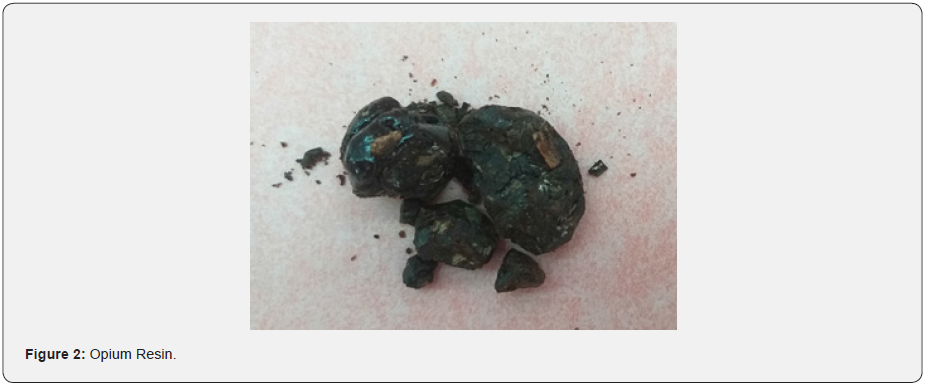

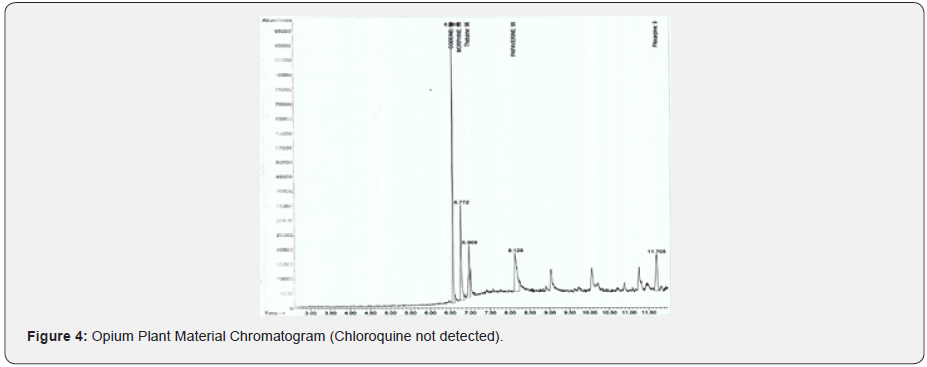
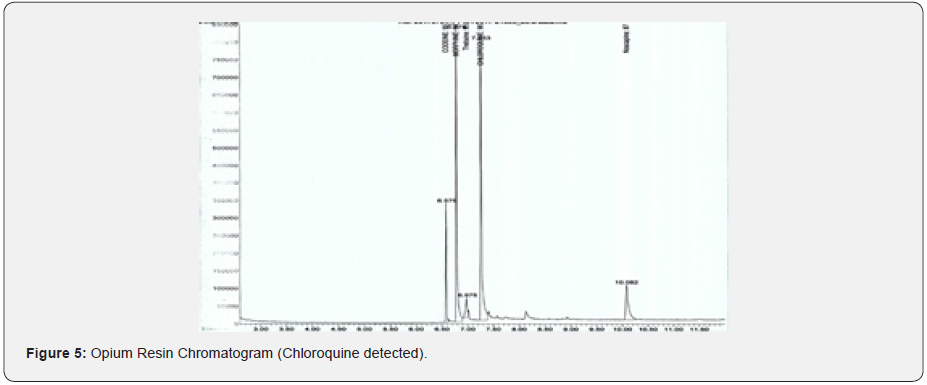

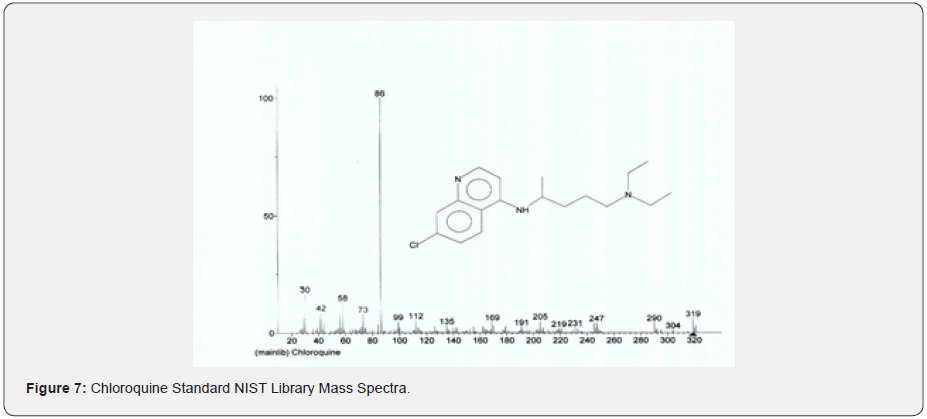
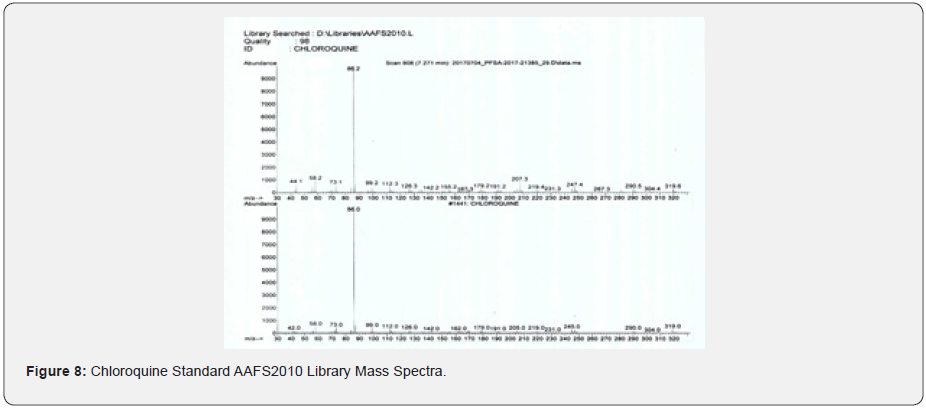

References
- (2014) United Nations International Drug Control Programme, in World drug report New-York, USA.
- Narayanaswami K, H Golani, R Dua (1979) Assay of major and minor constituents of opium samples and studies of their origin. Forensic science international 14(3): 181-190.
- Frick, S (2004) Transformation of opium poppy (Papaver somniferum ) with antisense berberine bridge enzyme gene (anti-bbe) via somatic embryogenesis results in an altered ratio of alkaloids in latex but not in roots. Transgenic research 13(6): 607-613.
- Furmanec D (1974) Quantitative gas chromatographic determination of the major alkaloids in gum opium. Journal of Chromatography A 89(1): 76-79.
- Gómez Serranillos, PE Carretero, A Villar (1994) Analysis of poppy straw and poppy straw concentrate by reversed‐phase high‐performance liquid chromatography. Phytochemical Analysis 5(1): 15-18.
- Ayyangar N, S Bhide (1988) Separation of eight alkaloids and meconic acid and quantitation of five principal alkaloids in gum opium by gradient reversed-phase high-performance liquid chromatography. Journal of Chromatography A 436: 455-465.
- Hindson BJ (2007) Determination of opiate alkaloids in process liquors using capillary electrophoresis. Journal of pharmaceutical and biomedical analysis 43(3): 1164-1168.
- Trenerry VC, RJ Wells, J Robertson (1995) Determination of morphine and related alkaloids in crude morphine, poppy straw and opium preparations by micellar electrokinetic capillary chromatography. Journal of Chromatography A 718(1): 217-225.
- Reddy MM (2003) Application of capillary zone electrophoresis in the separation and determination of the principal gum opium alkaloids. Electrophoresis 24(9): 1437-1441.
- Bjornsdottir I, SH Hansen (1995) Determination of opium alkaloids in crude opium using non-aqueous capillary electrophoresis. Journal of pharmaceutical and biomedical analysis 13(12): 1473-1481.
- Liu C Z Hua, Y Bai (2016) Classification of Opium by UPLC‐Q‐TOF Analysis of Principal and Minor Alkaloids. Journal of forensic sciences 61(6): 1615-1621.
- Smith R (1973) Forensic identification of opium by computerized gas chromatography/mass spectrometry. Journal of Forensic Science 18(4): 327-334.
- Mohana M (2005) Principal opium alkaloids as possible biochemical markers for the source identification of Indian opium. Journal of separation science 28(13): 1558-1565.
- Reid RG (2007) Differentiation of opium and poppy straw using capillary electrophoresis and pattern recognition techniques. Analytica chimica acta 605(1): 20-27.
- Lurie IS, SG Toske (2008) Applicability of ultra-performance liquid chromatography-tandem mass spectrometry for heroin profiling. Journal of Chromatography A 1188(2): 322-326.
- Francis PS (2008) Chemiluminescence detection of opium poppy (Papaver somniferum) alkaloids. Journal of pharmaceutical and biomedical analysis 48(3): 508-518.
- Taheri MS (2008) Swallowed opium packets: CT diagnosis. Abdominal imaging 33(3): 262-266.
- Jones O, B Shorey (2002) Body packers: grading of risk as a guide to management and intervention. Annals of the Royal College of Surgeons of England 84(2): 131.
- Wetli C, R Mittleman (1981) The “body packer syndrome”-toxicity following ingestion of illicit drugs packaged for transportation. Journal of Forensic Science 26(3): 492-500.
- Kashan J, AM Ruha (2004) Methamphetamine toxicity secondary to intravaginal body stuffing. Journal of Toxicology: Clinical Toxicology, 42(7): 987-989.
- Fineschi V (2002) The cocaine “body stuffer” syndrome: a fatal case. Forensic science international 126(1): 7-10.
- Emam HM, A Aghabeyglouei, J Gharahdaghi (2003) Fatal opioid body packing: Report of a mummified case.
- (2017) The History of Malaria, an Ancient Disease.
- Veinot JK Mai, R Zarychanski (1998) Chloroquine related cardiac toxicity. The Journal of Rheumatology 25(6): 1221-1225.
- Keller T (1998) Fatal chloroquine intoxication. Forensic science international 96(1): 21-28.
- Kelly JC (1990) Chloroquine poisoning in a child. Annals of emergency medicine 19(1): 47-50.
- Meyer F (1994) Indicative therapeutic and toxic drug concentrations in plasma: a tabulation. International journal of clinical pharmacology and therapeutics 32(2): 71-81.
- Cann HM, HL Verhulst (1961) Fatal acute chloroquine poisoning in children. Pediatrics 27(1): 95-102.
- Magureanu IG Schmitt, H Joachim (1992) Suicide with chloroquine combined with maprotiline and trimipramine. Archiv fur Kriminologie 190(3-4): 82-87.
- Croes KP, Mc Carthy, R Flanagan (1994) Simple and rapid HPLC of quinine, hydroxychloroquine, chloroquine, and desethylchloroquine in serum, whole blood, and filter paper-adsorbed dry blood. Journal of analytical toxicology 18(5): 255-260.
- Microgram Bulletin (2004) XXXVII (09): 159-178.
- Sulaiman M (2018) Heroin in Malaysia and Singapore. Drug testing and analysis 10(1): 109-119.
- (2015) Organization WH, Guidelines for the treatment of malaria. World Health Organization.






























